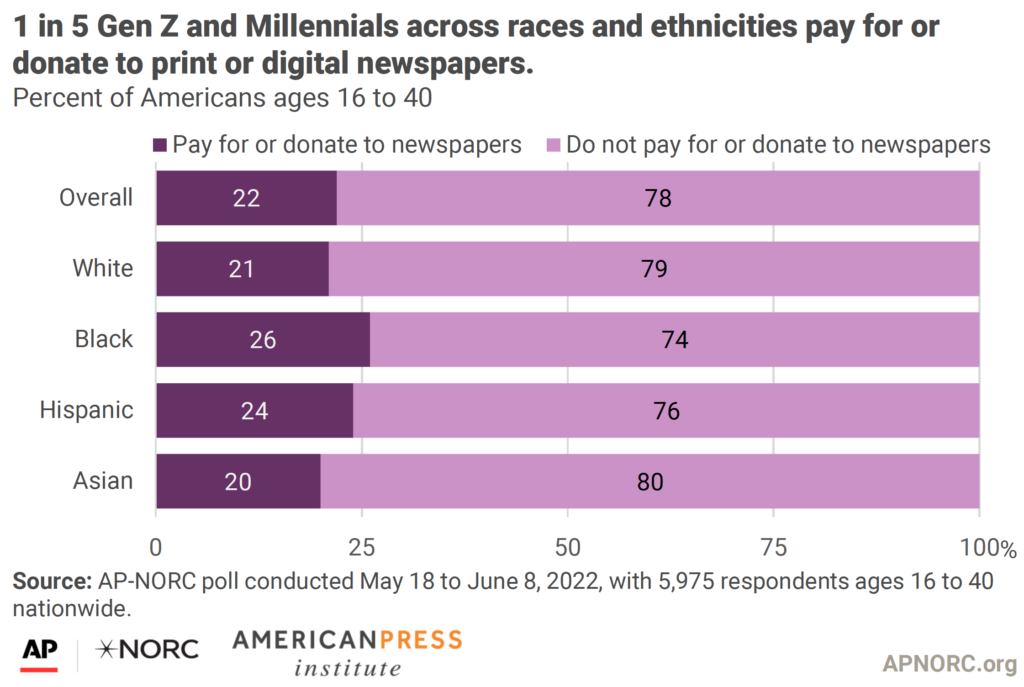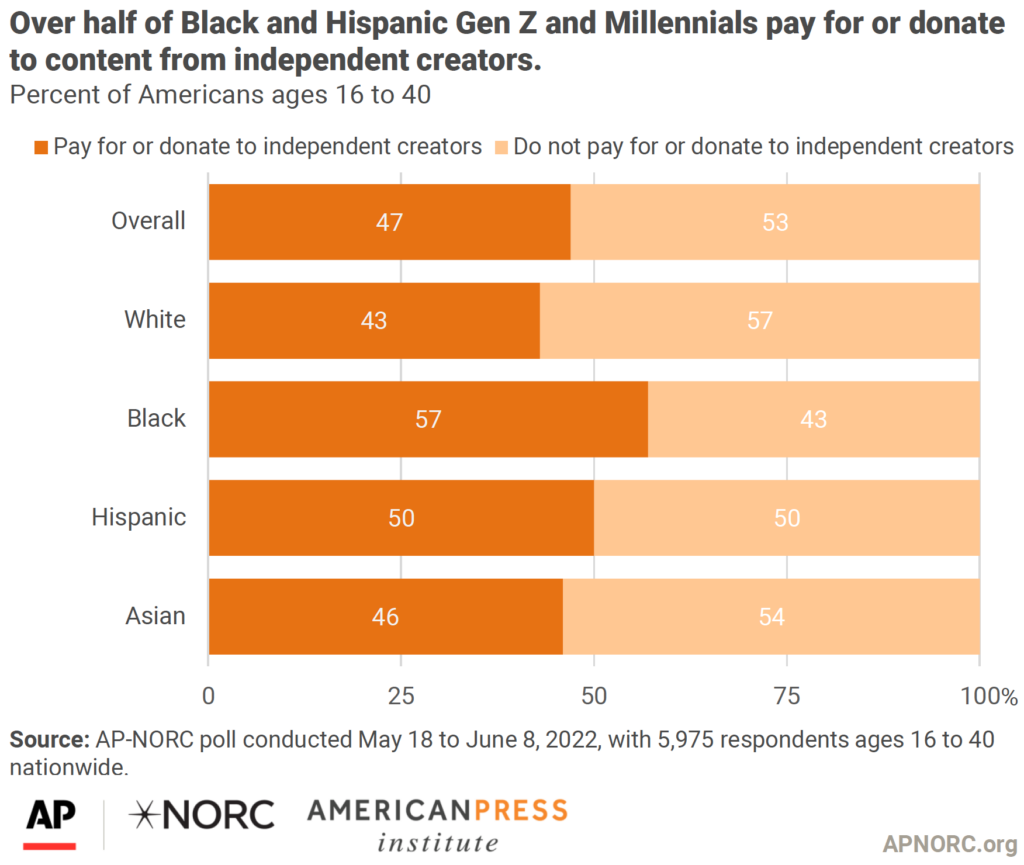How should news organizations appeal to Millennial and Gen Z news audiences and keep them coming back?
That question has been at the heart of a series of reports released in the past seven months by the Media Insight Project, a collaboration of The Associated Press-NORC Center for Public Affairs Research and the American Press Institute. We surveyed nearly 6,000 Americans ages 16 to 40, a scale that allows us to examine in-depth these diverse generations’ news habits and attitudes by a range of factors, such as race and ethnicity, location and political affiliation.
At the invitation of the Black Media Initiative at CUNY’s Center for Community Media, I recently presented some of this data including new findings on reaching Black Millennials and Gen Z specifically. With the research team’s help, we pulled data on where they get news and what they pay for or donate to, and I shared it in a session with Ryan Sorrell, founder and publisher of The Kansas City Defender. Sorrell was also one of a dozen local journalists serving young audiences that API consulted with to inform the survey’s questions.
Below are key points for reaching this demographic, some I discussed during the event and some I gathered based on the conversation.
1) Black Millennials and Gen Z get news daily from social media platforms at higher rates than white peers
Social media plays a large role in the news habits of all Millennials and Gen Z, as shown in our first report on these generations. For example, 74% of Gen Z get news daily from social media.
Black Gen Z and Millennials are particularly likely to get news daily from social media. In fact, they are more likely to get news daily on almost all of the platforms we evaluated.
Platforms where Black Millennials and Gen Z are much more likely to get news daily than white peers include Instagram, YouTube, TikTok and Twitter. Compared to Black peers, white Millennials were more likely to get news daily on LinkedIn and Reddit.
2) Many Black Americans under 40 get news daily on certain topics at higher rates than white peers
In our second report, we evaluated the audiences under 40 for a total of six critical news topics. We first looked at a list of “hard news” topics and evaluated the three such topics that respondents said they follow most often: national politics and government; social issues such as abortion, gun policy or LGBTQ issues; and crime and public safety. Then we did the same for “news you can use” topics, where the most often followed were information on traffic, transportation and weather; practical COVID-19 information; and information related to health or mental health.
When you look at the close followers of several of these topics, Black Millennials and Gen Z are more likely than their white peers to get news daily about it. This trend happens for the close followers of health or mental health, crime and public safety, and social issues. Here is an example of the trend we see:
However, the most often followed topics for Black Millennials and Gen Z differ slightly from the overall population of Americans under 40. Differences appear in the most often followed “hard news” topics. Race and social justice comes out on top, followed by schools and education. Two hard news topics tie for third: healthcare and public health gets the same amount of attention as crime and public safety.
3) Black Americans under 40 are more likely than their white peers to pay or donate to news
A majority of Americans under 40 pay or donate to news in some form, as our third report discusses.
Black Millennials and Gen Z are even more likely than their white peers to pay or donate to news in some fashion. Hispanic and Asian Gen Z and Millennials are also more likely.
Like others in their generations, Black Americans under 40 are much more likely to pay or donate to content from independent creators than print or digital newspapers.
Many Gen Z in general also pay or donate to independent creators — almost twice as many as do newspapers (42% to 16%).
4) Black Americans under 40 want many — but not all — of the same things from journalism as peers
Sorrell of The Kansas City Defender noted in his presentation that reaching Black Millennials and Gen Z is about more than being on the right platforms with the right topics. The style and emphasis of the journalism also matters.
During the Q&A, I looked up what our own data had to say on this point. We see some data that suggests the same.
Our survey asked how important it was for news media to perform a list of functions many may think of when it comes to the press’ role in society. While verifying and getting the facts right tops the list for every subgroup we’ve examined, other differences do exist by race and ethnicity.
In general, Black Millennials and Gen Z are less likely to say any particular function is extremely or very important. But the differences are largest for “be fair to all sides” (66% white to 50% Black) and “be neutral” (62% white to 43% Black).
Black Millennials and Gen Z were also less likely to say it is extremely/very important to “provide diverse points of view” (59% white to 47% Black) and “Act as a watchdog of powerful institutions and people” (46% white to 37% Black).
???? Tools for engagement
API has a set of templates to help build audience and loyalty on Instagram. We offered these templates, built by freelance audience consultant Adriana Lacy for our API Listening & Sustainability Lab for publishers of color, when speaking at the Black Media Initiative event. Anyone is welcome to take and adapt them for your own needs.
In addition, API’s Product Strategy team recently shared a zine of community engagement ideas, several of which go beyond social media. While Meta, Twitter and other platforms can always make changes to how they treat news, in-person engagement like community office hours and maker sessions are ways to build relationships and even introduce yourself to audiences of all ages.
Here are a few other relevant links I’ll leave you with:
- How the Florida Times-Union used Instagram to connect with a younger, more diverse audience
- How The Atlanta Journal-Constitution is reaching Black audiences through its Unapologetically ATL newsletter
- How Gannett’s Knoxville News Sentinel got a wakeup call and shifted its coverage for Black communities
Share with your network
You also might be interested in:
Successfully and efficiently marketing your work can be hard, especially for local news teams with limited resources, but marketing yourself to your audience is an essential skill for news organizations to drive revenue and promote sustainability.
As news teams begin thinking about their election coverage plans, it may feel like adding more tasks to an already full plate, with a fraction of the staff and resources they once had. But that doesn’t have to mean figuring out how to do more with less — maybe it’s doing less with less.
We reached out to Danielle Coffey, the CEO of American Press Institute’s parent corporation, the News/Media Alliance, to learn more about the legal fight for news organizations’ rights with AI.










